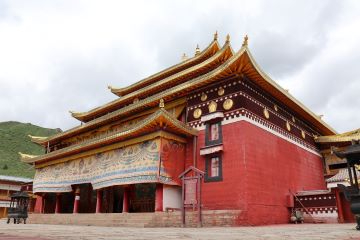Qionghai Lake

Name in Chinese: 邛海 Qióng Hǎi [tʃɔ:n hai]
Duration of Tour: A Whole Day
Location: No.28, the Middle Section of Haibin Road, Xichang, Liangshan Yi Group Autonomous Prefecture, Sichuan Province
Highlights: Photography and Authentic Yi People’s Folk Customs
Must-see Sightseeing Spots: the Waterside Village in Dreamworld and Xichang Lushan Mountain
Reputations: A National Wetland Park, A National Four-star Scenic Area, One of the Top Ten Bird-watching Ecotourism Resorts in China
Qionghai Lake lies about 5 km(3 miles) from downtown Xichang. It is the second largest freshwater lake in Sichuan Province. The lake is 30 square kilometers(11.6 sq.mi) in area. Qionghai Lake is 34 meters(112 feet) in depth at its deepest part. Its average depth is 14 meters(46 feet). The wetland by the lake is the home of wild birds, such as egrets and gray cranes. Xichang is the capital city of Laingshan Yi Group Autonomous Prefecture. Its altitude is about 1,500 meters(4,921 feet) above sea level. The city proper covers an area of 44 square kilometers(17 sq.mi) with a population of 300,000. Xichang is well-known as the City of Sunshine. It is one of the major fruit producers in China. The city is inhabited by Yi people. The total population of Yi Group in China is about 8.8 millions. Most of them live in the southwest part of Sichuan Province. Yi people can be also found in Yunnan Province, Guizhou Province and Guangxi Zhuang Group Autonomous Region. The Scenic Area comprises six parts, namely the Waterside Village in Dreamworld, the Bird-watching Park, the Flower Park, the Rural-styled Park, the Egret Bay Shrouded in Mist and the Crane Bay. Among the six parks, the Waterside Village is the most beautiful one.
The Waterside Village in Dreamworld
The Waterside Village is a wetland park located in the northwest of the lake. It covers an area of 173 hectares(428 acres). The park was opened to the public in 2012. It is the most ideal place for people to relax themselves in the scenic area. Visitors can walk along the path by the lake or take a boat trip on the lake. Reeds grow in the water. It is the happy land for the wild birds.
Xichang Lushan Mountain
It is called Lushan Mountain in Chinese. Its summit is 2,317 meters above sea level. The mountain overlooks the lake. Lushan Mountain Scenic Area consists of two sightseeing spots, namely, the Yi Nationality’s Slavery Museum and Guangfu Monastery
The Yi Nationality’s Slavery Museum
The Museum was opened to the public in 1985. It showcases the culture and tradition of Yi Nationality. Yi people speak their mother language and preserve their own tradition and folk customs. They were divided into five classes before 1949, when the slavery was abolished. The five classes were Zimo, Nuohe, Qunuo, Ajia and Gaxi. Zimo means power in English. It refers to the chieftains who occupied different lands. Nuohe means black and slave owner. It refers to the family members of the chieftains. Both the chieftains and their family members were called the Black Yi or the nobles. Quno, Ajia and Gaxi were slaves. They were called the White Yi. The slaves were not allowed to marry the nobles. The Torch Festive is the most important celebration of Yi people. It is held in July once a year. The celebration lasts three days. Local people are dressed in the traditional way, singing and dancing together.
Guangfu Monastery
Guangfu Monastery was originally built in 642, the fifteenth year of Taizong Emperor’s reign, the Tang Dynasty(618-907). It used to be called the Grand Buddha Monastery in ancient times. The present building could be dated back to 1882, the eighth year of Emperor Guangxu’s reign, the Qing Dynasty(1644-1911). The monastery is a huge compound in which a group of buildings stand. The buildings are the Heavenly Kings Hall, the Tower for Overlooking the Lake, the Three Saints Hall, the Hall of Avalokitesvara Bodhisattva, the Mahavira Hall and the Shrine of Both Meng’s Family and Duan’s. There is a cypress tree in front of Meng-duan Shrine. It was planted over 2,000 years ago. Guangfu Monastery is the most ideal place for overlooking the lake.
Travel Tips
How to Get to Qionghai Lake
Qionghai Lake lies about 5km from the city proper of Xichang. The distance between Xichang and Chengdu is 436 km(271 miles). Visitors can take a fight from Chengdu to Xichang, or ride a car. It takes five and a half hour to get to Xichang from Chengdu along the expressway by a car.
Photography Tips
A tripod, a filter, telephoto lenses and wide angle lenses are needed. We suggest our clients to go to Lushan Mountain in the morning, and take photos in the late afternoon before the sunset. The magic hour creates magical photos.
Weather
As the city of sunshine, the climate in Xichang is quite pleasant all year around. The temperature in Xichang ranges from 7℃(44.6°F) to 21℃(60.8°F) in spring, 17℃(62.6°F) to 28℃(82.4°F) in summer, 19℃(66.2°F) to 29℃(84.2°F) in autumn and minus 9℃(48.2°F) to 20℃(68°F) in winter.
Recommended Tour
Related Articles:
Lugu Lake
Xichang Travel Guide
Chengdu Travel Guide
Author: Tina Luo
Update:
